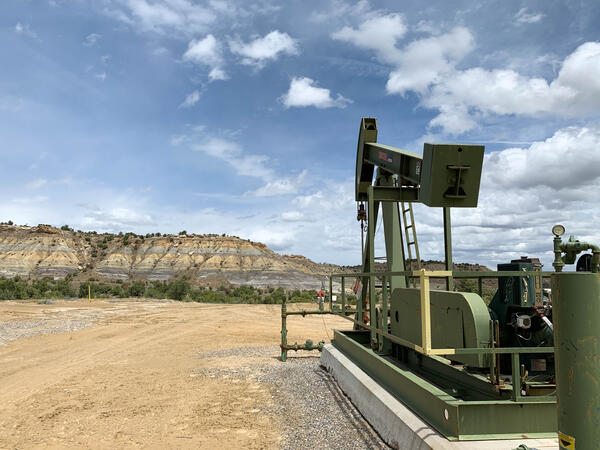A pumpjack on an active oil or gas drilling site near Farmington, New Mexico. Photo by Mike Duniway, USGS, SBSC.
What is associated vs. non-associated natural gas?
Associated (or associated-dissolved) gas is natural gas that is produced along with crude oil, and typically separated from the oil at the wellhead. In contrast, non-associated gas is produced from a well in conventional gas fields that do not produce crude oil.
There is also a third category of natural gas production, continuous (or unconventional) gas, that occurs as basin-centered gas, coal-bed gas, shale gas, fractured-reservoir gas, and tight-reservoir gas.
Learn More:
Related
Why do USGS oil and gas resource assessments differ from other oil and gas assessments from other agencies or industry?
Why does the USGS decide to reassess oil and gas formations?
Can the oil and gas that the USGS assesses be produced today?
What are the different columns on a USGS oil and gas resource assessment table?
What is the difference between assessed oil and gas “resources” and “reserves”?

A pumpjack on an active oil or gas drilling site near Farmington, New Mexico. Photo by Mike Duniway, USGS, SBSC.
Water truck in background is providing maintenance water to a producing well drilled in the Bakken Formation near Williston, North Dakota.
Water truck in background is providing maintenance water to a producing well drilled in the Bakken Formation near Williston, North Dakota.
The Nation relies on oil and gas to power its economy, and unconventional gas is the fastest-growing energy resource in the United States. The U.S. Geological Survey is the authoritative, unbiased source for assessments of the world's oil and gas endowment. Come learn how these exciting new energy resources may contribute to the energy mix.
The Nation relies on oil and gas to power its economy, and unconventional gas is the fastest-growing energy resource in the United States. The U.S. Geological Survey is the authoritative, unbiased source for assessments of the world's oil and gas endowment. Come learn how these exciting new energy resources may contribute to the energy mix.

A drill rig at the Mount Elbert test site in Alaska's North Slope, just west of Prudhoe Bay. USGS joined BP Exploration (Alaska) and the U.S. Department of Energy to drill a test well to study natural gas production from gas hydrate deposits. Read more about the Mt.
A drill rig at the Mount Elbert test site in Alaska's North Slope, just west of Prudhoe Bay. USGS joined BP Exploration (Alaska) and the U.S. Department of Energy to drill a test well to study natural gas production from gas hydrate deposits. Read more about the Mt.

Test drilling in North Canadian River Valley, Canadian County, Oklahoma; Photograph by C.R. Frazier. A new length of drill-pipe is being raised into position so that hole can be deepened.
Test drilling in North Canadian River Valley, Canadian County, Oklahoma; Photograph by C.R. Frazier. A new length of drill-pipe is being raised into position so that hole can be deepened.
Assessment of continuous oil and gas resources in the Bakken Formation of northwest Montana, 2022
Comparison of natural gas assessments
Assessment of deep conventional and continuous-type (unconventional) natural gas plays in the United States
Shallow, low-permeability reservoirs of northern Great Plains: Assessment of their natural gas resources.
Natural gas: A perspective on resource availability
Related
Why do USGS oil and gas resource assessments differ from other oil and gas assessments from other agencies or industry?
Why does the USGS decide to reassess oil and gas formations?
Can the oil and gas that the USGS assesses be produced today?
What are the different columns on a USGS oil and gas resource assessment table?
What is the difference between assessed oil and gas “resources” and “reserves”?

A pumpjack on an active oil or gas drilling site near Farmington, New Mexico. Photo by Mike Duniway, USGS, SBSC.
A pumpjack on an active oil or gas drilling site near Farmington, New Mexico. Photo by Mike Duniway, USGS, SBSC.
Water truck in background is providing maintenance water to a producing well drilled in the Bakken Formation near Williston, North Dakota.
Water truck in background is providing maintenance water to a producing well drilled in the Bakken Formation near Williston, North Dakota.
The Nation relies on oil and gas to power its economy, and unconventional gas is the fastest-growing energy resource in the United States. The U.S. Geological Survey is the authoritative, unbiased source for assessments of the world's oil and gas endowment. Come learn how these exciting new energy resources may contribute to the energy mix.
The Nation relies on oil and gas to power its economy, and unconventional gas is the fastest-growing energy resource in the United States. The U.S. Geological Survey is the authoritative, unbiased source for assessments of the world's oil and gas endowment. Come learn how these exciting new energy resources may contribute to the energy mix.

A drill rig at the Mount Elbert test site in Alaska's North Slope, just west of Prudhoe Bay. USGS joined BP Exploration (Alaska) and the U.S. Department of Energy to drill a test well to study natural gas production from gas hydrate deposits. Read more about the Mt.
A drill rig at the Mount Elbert test site in Alaska's North Slope, just west of Prudhoe Bay. USGS joined BP Exploration (Alaska) and the U.S. Department of Energy to drill a test well to study natural gas production from gas hydrate deposits. Read more about the Mt.

Test drilling in North Canadian River Valley, Canadian County, Oklahoma; Photograph by C.R. Frazier. A new length of drill-pipe is being raised into position so that hole can be deepened.
Test drilling in North Canadian River Valley, Canadian County, Oklahoma; Photograph by C.R. Frazier. A new length of drill-pipe is being raised into position so that hole can be deepened.








